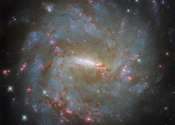A new horizon for the Kuiper Belt: Subaru telescope's wide-field observations
The Subaru Telescope's wide and deep imaging observations are contributing information to the New Horizons spacecraft as it moves through the outer solar system. By applying a unique analysis method to images of Kuiper Belt ...









